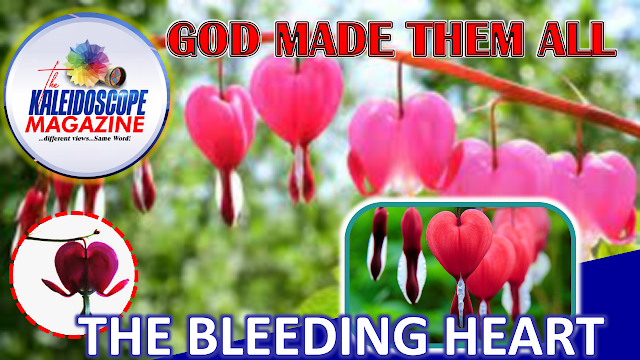GOD MADE THEM ALL: THE BLEEDING HEART
THE BLEEDING HEART
Lamprocapnos Spectabilis, bleeding heart, fallopian buds or Asian bleeding-heart, is a species of flowering plant belonging to the fumitory subfamily (fumarioideae) of the poppy family Papaveraceae, and is native to Siberia, northern China, Korea, and Japan.
It is the sole species in the monotypic genus Lamprocapnos, but is still widely referenced under its old name Dicentra spectabilis (now listed as a synonym), not to be confused with the North American native bleeding heart plants also classified under Dicentra. It is valued in gardens and in floristry for its heart-shaped pink and white flowers, borne in spring.The Asian bleeding-heart grows to 120 cm (47 in) tall by 45 cm (18 in) wide. It is a rhizomatous herbaceous perennial with 3-lobed compound leaves on fleshy green to pink stems.
The arching horizontal racemes of up to 20 pendent flowers are borne in spring and early summer. The outer petals are bright fuchsia-pink, while the inner ones are white. The flowers strikingly resemble the conventional heart shape, with a droplet beneath – hence the common name.
The plant sometimes behaves as a spring ephemeral, becoming dormant in summer.
In a moist and cool climate, it will grow in full sun, but in warmer and drier climates it requires some shade.
Aphids, slugs and snails sometimes feed on the leaves.
Clumps remain compact for many years and do not need dividing. They have brittle roots which are easily damaged when disturbed. Root cuttings should be taken in spring. Seeds with whitish elaiosomes are borne in long pods.
They must be sown while fresh. Division should be done in the late fall (autumn) or early spring.
These easy-care, shade-loving perennials pop up in early spring and grow quickly. Their characteristic heart-shaped flowers bloom in shades of pink, red or white and hang delicately from arching stems from late spring to early summer.
Common bleeding heart plants (Lamprocapnos spectabilis, formerly Dicentra spectabilis) die back after flowering, but don’t worry — they’ll return again the following spring. Dicentra eximia varieties, also called fringed bleeding hearts, bloom for a longer time and don’t go dormant.
Such a beauty to behold.
ALL THINGS BRIGHT AND BEAUTIFUL,
THE LORD GOD MADE THEM ALL








Comments